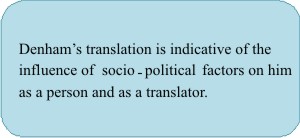John Denham
The example that Venuti gives to illustrate the rise of the concept of fluency is Sir John Denham’s. Denham was a translator in the seventeenth century and lived through the Caroline and Commonwealth eras of British history. In 1656 h e published a translation titled The Destruction of Troy, An Essay upon the Second Book of Virgils Aeneis. Written in the year 1636. What was significant about this book was that it did not carry the name of the author, unlike books of those days and even today. Why did Denham omit to mention his name on the title page? According to Venuti, the reasons are many. It could have been sheer humility, or a tacit admission that this work was not really significant but was a mere literary pastime. People who really worked, in accordance with the belief of those times, worked for the king either in the court or the army. Denham did neither of these things. Venuti interprets Denham’s title page as a “distinctively aristocratic gesture in literary translation, typical of court culture in the Tudor and Stuart periods…” (44). e published a translation titled The Destruction of Troy, An Essay upon the Second Book of Virgils Aeneis. Written in the year 1636. What was significant about this book was that it did not carry the name of the author, unlike books of those days and even today. Why did Denham omit to mention his name on the title page? According to Venuti, the reasons are many. It could have been sheer humility, or a tacit admission that this work was not really significant but was a mere literary pastime. People who really worked, in accordance with the belief of those times, worked for the king either in the court or the army. Denham did neither of these things. Venuti interprets Denham’s title page as a “distinctively aristocratic gesture in literary translation, typical of court culture in the Tudor and Stuart periods…” (44).
What is more significant is the time period that has elapsed between the writing of the book and its publication. Denham specified that he had written it in 1636 and published it only in 1656. What happened in between? In 1636 Denham was a young apprentice lawyer who also dabbled in literary pursuits like translation. Charles I was on the throne of England. Denham was a royalist and also a follower of the literary fashions of the day. The ousting of the King and his eventual execution by the Parliament was to have consequences for Denham too. He was exiled to France, and later arrested for being part of a plot to overthrow Puritan rule. By 1656, he was a tried and tested royalist, as well as author of his best known work Cooper’s Hill. Politically, this was the period known as Interregnum in British history when Oliver Cromwell’s Protectorate was ruling England. This was to end in 1660 with the restoration of Charles II to the throne.
Venuti observes that Denham’s gesture of mentioning the year in his translation of Virgil gains in significance, given the circumstances in which it was published. It is openly looking back to a past in which royalty was unchallenged. He also makes it clear in his preface that one of the aims of the work was to introduce a new translation aesthetics which could be picked up by future generations of aristocrats. His aristocratic leanings were not concealed; on the contrary, it was advertised along with the book in the leading journals of the time.
|